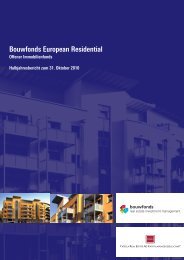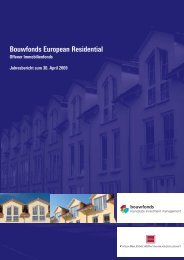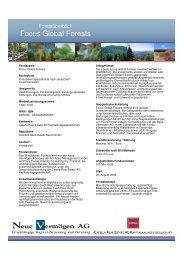Bouwfonds European Residential - Catella Real Estate AG
Bouwfonds European Residential - Catella Real Estate AG
Bouwfonds European Residential - Catella Real Estate AG
You also want an ePaper? Increase the reach of your titles
YUMPU automatically turns print PDFs into web optimized ePapers that Google loves.
Fund Management Report<br />
<strong>Real</strong> estate investment markets<br />
2008 proved to be extremely difficult for international real<br />
estate markets, as for many other sectors. For example, the<br />
INREV “All Property <strong>European</strong> Total Return Index” recorded<br />
a drop of 26.8% in 2008, which was mainly due to a 30.3%<br />
depreciation in property values. However, total returns in the<br />
BVI index averaged 4.4% in Germany. Here, the financial<br />
crisis made itself felt in a different way: in the temporary<br />
closing of 12 open-ended real estate funds.<br />
One positive result of the financial crisis is that professional<br />
investors are increasingly seeing residential property as an<br />
independent asset class. According to INREV’s 2009<br />
“Investment Intention Survey”, German residential properties<br />
are the number one investment target for institutional<br />
investors in Europe. This is reflected in increasing competition<br />
among providers of comparable products. However,<br />
<strong>Bouwfonds</strong> <strong>European</strong> <strong>Residential</strong> (BER) is currently the only<br />
fund in its segment that systematically ensures risk diversification<br />
by investing throughout Europe.<br />
<strong>Real</strong> estate markets<br />
In 2008, our target countries generated average economic<br />
growth of around 1.3% (Germany), 2.1% (Netherlands),<br />
0.7% (France) and 1.1% (Belgium). 1<br />
The trend in the number of households is of particular strategic<br />
interest as a long-term indicator. The tendency towards a<br />
rising number of households in BER’s target countries is<br />
having a positive effect on returns. In 2008, prices for residential<br />
real estate in our target countries performed as<br />
follows:<br />
France: At 0.6%, the rise in purchase prices for existing residential<br />
real estate of was restrained. However, considerable<br />
regional differences were recorded (e.g. Grenoble –4.7%<br />
versus Paris +8.7%).<br />
Rental price trends for French residential properties also<br />
varied in line with this, with the slight overall increase of<br />
1.4% being spread unevenly across the regions. Whereas<br />
Grenoble, Montpellier and Paris, for example, saw increases<br />
of between 2.3% and 4.3%, rents in Lyon, Marseille and<br />
Toulouse stagnated. 2<br />
8<br />
Germany: A slight decline in prices – but still within the<br />
bounds of normal price fluctuations – was felt across<br />
Germany. Prices for existing real estate fell on average by<br />
between 0.5% and 1.0%, while prices for new builds in the<br />
residential segment were flat. However, significant regional<br />
differences are to be seen in both areas, with price increases<br />
of up to 8.0% in large cities.<br />
As a whole, rental prices across Germany remained relatively<br />
stable. Metropolitan areas in particular saw increases of<br />
2.0% to 4.0% for new lettings. In contrast, structurally weak<br />
rural regions experienced increasing vacancies and a slight<br />
drop in rental prices. 3<br />
Netherlands: Prices for residential properties remained<br />
unchanged between 2007 and 2008. The slight price increases<br />
seen in the summer levelled off again at the end of the year. 4<br />
The rental market recorded an annual average rise of 1.9%. 5<br />
Belgium: The prices for residential real estate in Belgium<br />
rose once again. Single-family homes saw a price increase of<br />
5.2% and apartment houses of 4.0%. In 2008, the rent index<br />
was 4.0% higher on average than the previous year. The last<br />
ten years saw average annual growth of 1.7%.<br />
<strong>Bouwfonds</strong> <strong>European</strong> <strong>Residential</strong>’s strategy<br />
The Fund is aiming for the following allocation during the<br />
first three years:<br />
• Germany (30%-50%)<br />
• France (30%-50%)<br />
• Benelux (10%-40%)<br />
In addition, the Fund can invest up to 10% of fund assets in<br />
other countries in the <strong>European</strong> Economic Area and<br />
Switzerland. However, since the Fund follows a regional<br />
strategy that involves making focused investments in regions<br />
with above-average growth, it is equally important to<br />
consider the regional allocation:<br />
• Service regions (40%-60%)<br />
• High-tech regions (20%-30%)<br />
• Financial services regions (20%-30%)<br />
• “Government and administrative locations” (10%-20%)<br />
1 Source: Eurostat<br />
2 Sources: Callon, CNAB, OLAP<br />
3 Source: IVD, Wohnpreisspiegel 2008/2009<br />
4 Source: Nederlandse Vereniging van Makelaars o.g. en vastgoeddeskundigen NVM, NVM-cijfers van het 1 kwartaal 2009 voor heel Nederland<br />
5 Source: Centraal Bureau voor de Statistiek, Consumentenprijzen; de gemiddelde verhoging woninghuur in Nederland







